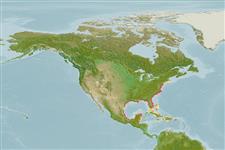>
Cyprinodontiformes (Rivulines, killifishes and live bearers) >
Fundulidae (Topminnows and killifishes)
Etymology: Lucania: Taken from the Italian province of Lucania, near tarento (Ref. 45335); parva: Lucania (coined name without meaning); parva meaning small (Ref. 79012).
More on authors: Baird & Girard.
Environment: milieu / climate zone / depth range / distribution range
Écologie
marin; eau douce; saumâtre; amphidrome (Ref. 51243); profondeur 0 - 2 m. Subtropical; 10°C - 25°C (Ref. 2059); 43°N - 17°N, 98°W - 69°W
Western Atlantic: Massachusetts and northern Gulf of Mexico to Florida Keys in USA and northeastern Mexico. Ascends Rio Grande and Pecos River in Texas and New Mexico in USA (Ref. 5723).
Length at first maturity / Taille / Poids / Âge
Maturity: Lm 2.5 range ? - ? cm
Max length : 6.2 cm TL mâle / non sexé; (Ref. 37039); common length : 3.7 cm TL mâle / non sexé; (Ref. 12193)
Rayons mous dorsaux (Total): 11-12
Inhabits vegetated quiet water and usually swims several inches below surface of water. 7 cm max TL (Ref. 5723). Feeds on larval crustaceans (mainly cyclopoid and harpacticoid copepods), mosquito larvae, small worms, and mollusks (Ref. 79012). Not a seasonal killifish. Is difficult to maintain in aquarium (Ref. 27139).
Huber, J.H., 1996. Killi-Data 1996. Updated checklist of taxonomic names, collecting localities and bibliographic references of oviparous Cyprinodont fishes (Atherinomorpha, Pisces). Société Française d'Ichtyologie, Muséum National d'Histoire Naturelle, Paris, France, 399 p. (Ref. 27139)
Statut dans la liste rouge de l'IUCN (Ref. 130435)
Menace pour l'homme
Harmless
Utilisations par l'homme
Aquarium: Commercial
Plus d'informations
RéférencesAquacultureProfil d'aquacultureSouchesGénétiqueElectrophoresesHéritabilitéPathologiesTraitementNutrientsMass conversion
CollaborateursImagesStamps, Coins Misc.SonsCiguateraVitesseType de nageSurface branchialeOtolithesCerveauxVision
Outils
Articles particuliers
Télécharger en XML
Sources Internet
Estimates based on models
Preferred temperature (Ref.
123201): 12.7 - 26.7, mean 23.7 °C (based on 167 cells).
Phylogenetic diversity index (Ref.
82804): PD
50 = 0.6250 [Uniqueness, from 0.5 = low to 2.0 = high].
Bayesian length-weight: a=0.01202 (0.00614 - 0.02355), b=3.15 (2.98 - 3.32), in cm total length, based on LWR estimates for this species & (Sub)family-body (Ref.
93245).
Niveau trophique (Ref.
69278): 3.2 ±0.2 se; based on size and trophs of closest relatives
Résilience (Ref.
120179): Haut, temps minimum de doublement de population inférieur à 15 mois (Preliminary K or Fecundity.).
Fishing Vulnerability (Ref.
59153): Low vulnerability (10 of 100).
Nutrients (Ref.
124155): Calcium = 407 [194, 1,040] mg/100g; Iron = 2.72 [1.33, 5.23] mg/100g; Protein = 18.8 [17.5, 20.2] %; Omega3 = 0.458 [0.204, 1.045] g/100g; Selenium = 8.46 [3.41, 21.28] μg/100g; VitaminA = 21.6 [6.4, 81.3] μg/100g; Zinc = 2.32 [1.44, 3.65] mg/100g (wet weight);
